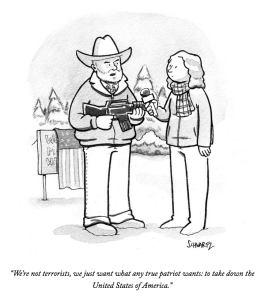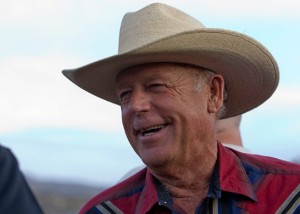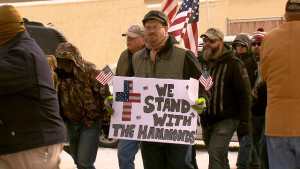“A well regulated militia, being necessary to the security of a free state, the right of the people to keep and bear arms, shall not be infringed.”
– Second Amendment to the U.S. Constitution.
——-
As word spread over the weekend about the armed takeover of a federal wildlife refuge in Oregon by a self-styled militia group social media lit up. One posting asked if the protesters represented “that well regulated militia” we hear so much about. The New Yorker’s Andy Borowitz suggested that Oregon erect a 20-foot high wall around the state to keep out angry white men and that any angry white guys currently in the state be deported to, say, Texas. There were debates over whether the occupiers were “protesters” or “terrorists.”

In all seriousness this is no laughing matter. There is a crazy saga, long in the making and dangerous in its potential, unfolding in the remote high desert near the rural cowboy and timber town of Burns, Oregon.
This is a reaction against many perceived wrongs, including the American judicial system and the long established notion that all the people of the United States own the public’s land. The forefathers of Oregon’s current takeover gang cut their teeth on the mostly manufactured outrage that drove the Sagebrush Rebellion in the 1980’s and the even earlier Posse Comitatus movement. Some of the rugged individuals of the American West have always been in revolt against what they consider an alien government. Some things never change.
It should also probably not be a great surprise, given the current state of American politics and the desire by too many to make the most of the anger that seems to pervade every public issue, that we would eventually have to confront a bunch of gun toting radicals occupying a bird sanctuary as they make some kind of point about how much they disagree with “the feds.”
To say that the “standoff” is dangerous, as in Ruby Ridge or Waco dangerous, is to understate the broader implications. The armed guys in cowboy hats initially showed up in Burns to protest the judicial treatment of two local ranchers, but as the local sheriff said over the weekend, “these men had alternative motives to attempt to overthrow the county and federal government in hopes to spark a movement across the United States.” The self-styled “militiamen” in Oregon are not a new phenomenon in the West, but perhaps they do represent a more aggressive strain of land use protesters than we have seen in a while.

The takeover group, apparently all from outside the local community, clearly rejects much of the established system of law and justice in the country and embraces a version of the American Constitution that, despite what they say and obviously believe, has never existed.
Most westerners adhering to such beliefs live out there “off the grid,” desiring to be left alone, not paying their taxes and believing that the Founders sanctioned such nonsense. Once in a while one gets elected to something, but since they don’t really believe in government the tenure of office is usually pretty short.
The yahoos in Oregon, by contrast, seem to have spontaneously decided to occupy a remote wildlife refuge in the dead of winter and vowed to stay, well, forever. But demanding what exactly? That the federal government disappear? That the land Thomas Jefferson sent Lewis and Clark to explore in 1803 be privatized?
The Roots of Protest…
This “protest” is as incoherent as the beliefs of the protesters, but we can surely trace the current eastern Oregon standoff to the federal government’s earlier incoherent and ineffective response to southern Nevada rancher Cliven Bundy’s blatant disregard of federal law back in 2014. Bundy and his followers, armed to the teeth, bullied and threatened federal officials to such a degree that the government backed down and continued to allow Bundy to graze cattle illegally on public lands without paying you and me for the privilege of doing so.
You will remember that Bundy’s case became a several day sensation on Fox News with politicians like Senator Rand Paul shamelessly pandering to deeply engrained anti-public lands sentiment among many hard right conservatives (or libertarians) in the West.

Now, Bundy’s sons have led the armed takeover of the wildlife refuge in Oregon based on the completely specious argument that public land is illegal. Even a public land skeptic like Randal O’Toole of the libertarian Cato Institute says the takeover is crazy.
“The Supreme Court has heard hundreds of cases involving federal land and has never ruled that the Constitution does not allow the federal government to own land in the West,” O’Toole writes. “So any battle against federal ownership would have to fought politically, not in the courts.” Taking that approach, of course, would mean that people who don’t accept settled law on a whole range of things and feels it’s fine to threaten harm to public officials would suddenly have to accept that they can never prevail in a political process in a democratic system.
O’Toole also points out that 90% of westerners live in urban areas where many people actually like wildlife refuges and enjoy national parks. Sympathy for “spotted owls and sandhill cranes” in the urban West is a good deal greater than for sheep and cattle or for cowboys who don’t pay their way. But then again true believers don’t have to believe in rules made for the rest of us.
The federal government has long and often been a target for the legitimate grievances of many people who live in the wide-open spaces of the West. The rules and regulations often seem arbitrary, confusing or misguided, The paperwork is annoying and the economic ups and downs of the resources industries can stimulate anger about a way of rural life that seems fragile, even fleeting to many. And if you don’t subscribe to the law, not to mention the philosophy of the greatest good for the greatest number, you conveniently don’t have to worry about clean water, endangered species or paying for our rangeland.
But what is happening in Oregon and happened before in southern Nevada goes beyond legitimate grievance. This is no mere “protest against government,” but instead the Bundys and their followers have walked right up to the line of sedition.
When an earlier day “terrorist” by the name of John Brown, admittedly acting on behalf of a much better cause than the Bundy’s, seized a federal armory at Harper’s Ferry, Virginia in 1859 in an act of revolt against the federal government he was tried and executed. Most of us would probably be content to see the Bundy Gang indicted for using weapons to seize a federal facility, a felony crime, by the way, that ironically would prevent anyone found guilty of violating from owning a gun.
The federal government’s failure to enforce the law against Cliven Bundy in 2014 sent a signal to his sons in 2016 and they have now acted on that signal in Oregon. The message was sent that the essential social and legal compact we make with each other as Americans can be disregarded if a self-styled militiaman hints at violence and commands enough media and political attention.
Back in 2014, the New York Times quoted Alan O’Neill, a one-time superintendent of the Lake Mead National Recreation Area in southern Nevada, who had experienced his own earlier run in with Cliven Bundy. “He calls himself a patriot, and says he loves America,” Mr. O’Neill said then. “And yet he says he won’t follow any federal laws. You just can’t let this go by, or everybody is going to be like, ‘If Bundy can break the law, why can’t I?’ ”
Welcome to Oregon 2016…
Turns out the Oregon ranchers who were convicted of arson – they set fire to public grazing lands without Bureau of Land Management approval and were senselessly sentenced under a federal terrorism statute – also have a bit of history. More than 20- years ago rancher Dwight Hammond was accused of “disturbing and harassing” federal officers. High County News reported in 1994 that, “a thick file at refuge headquarters [the same refuge now occupied by the Bundy Gang] reveals just how patient refuge managers have been” in dealing with Hammond, who “allegedly made death threats against previous managers in 1986 and 1988 and against…the current manager, in 1991” and again in 1994.
The newspaper also reported that Hammond had “never given the required 24 hours’ notice before moving his cows across the refuge and that he allowed the cows to linger for as long as three days, trespassing along streams and trampling young willows that refuge workers had planted to repair damage wrought by years of overgrazing.”
It is not difficult to conclude that the entire situation has been poorly handled by the government and by the cowboys. There is a widely held view, for example, that the punishment vastly exceeds the Hammond’s crime and a belief persists among many who have watched this case that a vindictive federal government, at best, is guilty of harassing the ranchers. No one should be so naive as to believe that such things do not happen. The government, too, makes mistakes.
Hard cases, they say, make bad law and this case is hard, unfortunate, troubling and may well demand a further review – including a clemency review – that is untainted by the emotions and history of Harney County.
It must be noted that on Monday the Hammonds turned themselves in, as scheduled, to face punishment and they had earlier taken significant steps to distance themselves from the refuge takeover. Nonetheless, it is important to separate the rancher’s case and the emotions surrounding it from the armed takeover of a federal facility which is a crime that demands a timely legal and law enforcement response.

Unlike the Fox News firestorm that made the southern Nevada Bundy incident a national story, this time most politicians, even Tea Party favorite Ted Cruz, have behaved sensibly.
“Every one of us has a constitutional right to protest, to speak our minds,” Senator Cruz told reporters in Iowa. “But we don’t have a constitutional right to use force and violence and to threaten force and violence against others. So it is our hope that the protesters there will stand down peaceably, that there will not be a violent confrontation.”
One has to sympathize with the local sheriff and other officials who seem determined to defuse the situation without someone getting hurt. But they need help. A good step toward defusing the situation and avoiding violence would be for more elected officials, particularly conservatives across the West to state the obvious: the United States is a nation of laws and not individuals and following the law is not an optional exercise.
You can dislike the law, you can peacefully protest, you can petition the government and elected officials to change the law. You can even commit civil disobedience if you are willing to accept the consequences. You cannot, however, ammo up and take the law into your own hands. You cannot pick and chose the laws you will obey and you cannot commit armed sedition.
Disregarding long established law – the Malheur National Wildlife Refuge at the center of the Oregon dispute was created in 1908 when that well-known political despot Teddy Roosevelt was president – only breeds more disregard. In a representative democracy laws matter and upholding the law matters just as much.






